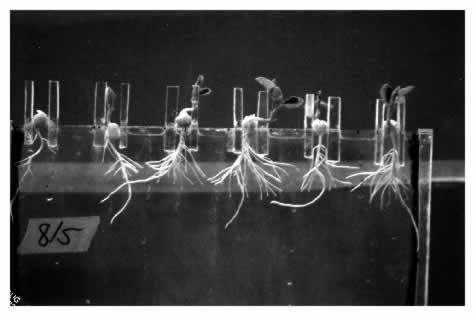HandsOn 21 - Growing Roots
In
this experiment you compare the branching patterns that arise when
a plant is grown hydroponically (with fertilizer in the water) to
the corresponding patterns when the plant is grown without fertilizer
in the water. During the experiment you take photographs of the
root system for measurement of the fractal dimension. Finally, once
a week for 1-2 months, you record the image of the root patterns
for a fractal dimensional analysis of your root system.
When
you record your observations at each date, you should include in
your table:
-
Length and number of vertical root branches (this includes both
primary and secondary root growth).
-
Length and number of lateral root branches.
-
Number and length of root hairs on vertical and lateral root growth.
(These are small and difficult to observe, so use a magnifying
glass to find the hairs.)
You grow roots in a rhizotron, two parallel sheets
of plastic enclosing a narrow sheet of water and nutrients.
This forces roots to grow primarily in two dimensions, not three
dimensions as they would naturally. Discuss ways that this might
affect the results. Do you expect it will increase or decrease
the fractal dimension of the resulting root pattern? What experiment
could you use to provide analysis of the full 3-dimensional
natural root system?
1. Create two groups of rhizotrons and seedlings. Be sure that both
groups consist of the same species of seedling.
a. Group A - using fertilizer and tap water to fill the rhizotron(s).
b. Group B - same as the control group but no fertilizer.
Use fertilizer with the mixture 20-20-20, which can be found
in any local gardening store. Mix 1 teaspoon of dry fertilizer
in 1 gallon (approximately four liters) of water and fill the
rhizotron.
2. Measure and record the root system before you begin the experiment.
Indicate the age of the seedling you are using and measure the
primary root, secondary root, and root hairs as described above.
3. Carefully place seedling in the rhizotron. (The seedlings are
delicate, so be careful not to disturb the roots too much).
4. Try to find a regular time at least once a week to make observations
and recordings with your lab partner.
5. If you have a digital camera, take an image of your root system
through the rhizotron cell similar to that shown in Figure . If
you have a scanner, take a picture of the root system, and scan
the photograph. This should be done periodically, roughly once
a week. Be sure to record root dimensions in your lab notebook
and save all your images.
Figure
5.11: Typical root growth results.
6. Keep a record of the color and size of the leaves and stem
of your seedling over this period of time. You may also consider
checking the pH of your solution periodically. Would you expect
this to be different in your groups (A and B) and would you expect
this to change over time?
Data
Analysis
1. After digitizing your images, use the Fractal
Dimension program to measure the fractal dimension of your root pattern.
2. From your recorded images, plot the length of the longest root
of the pattern vs. time and find the root growth velocity.
Explain the possible reasons for the shape of your curve. Compare
any similarities or differences you observe between groups A and
B.
3. From your notebook observations, investigate further the growth
velocity of both groups. Plot the length of the vertical roots
vs. time and the number of vertical roots vs. time on separate
graphs. Do the same plot for the length and number of horizontal
roots vs. time.
After a couple of weeks you may have several root branchings
to count. It is easier to plot this information if you average
the lengths of the root branchings and average the total numbers
of root branchings separately for the vertical and horizontal
growths. Plot these averages on your graph.
4. Now find the growth velocities of horizontal (primary and secondary)
roots. Explain the similarities and differences you observe or
any other observations that you anticipated or that surprised
you.
5. What can you say about root patterns and nutrient solutions?
What differences did you find in root growth between the two different
nutrient solutions?
6. A number of researchers have written computer programs that
simulate root growth under conditions similar to those you have
used. How would you use random walkers to create a model of root
growth?
Previous: HandsOn
20 - Building a Rhizotron and Germinating Seeds
